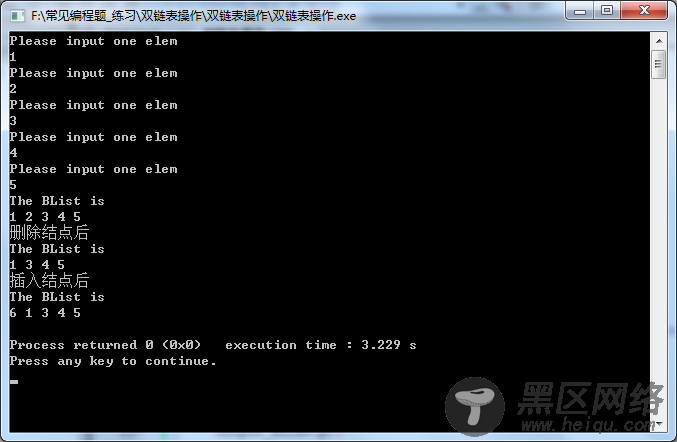双向链表的情况与单链表类似,只是增加了一个前置链(即指向前一结点的指针域)
算法等,与单链表很相似。只是需要安置好前向指针域。
注意点:在写关于链表的插入删除操作时,一定要注意该结点是不是最后一个结点,以免出现 p->next == NULL,p->next->next 未定义的情况,从而导致程序在特定条件下(比如你删除最后一个节点)出错。
也就是需要注意,最后一个节点和其他节点的操作不同,需要分开写。
以下是代码:
#include <iostream> using namespace std; typedef struct BNode{ int data; struct BNode *pre,*next; }BListNode; /**双链表创建*/ BListNode * Create_BList(int n) { int i = 1; int elem; BListNode *head, *temp, *curr; /**curr:代表一个当前节点,它的下一节点是你正要创建的。*/ /**temp:代表你正要创建的节点。*/ head = new BListNode; head->data = n; head->pre = NULL; head->next = NULL; curr = head; while(i <= n) { cout << "Please input one elem" << endl; cin >> elem; temp = new BListNode; temp->data = elem; temp->pre = curr; temp->next = NULL; curr->next = temp; curr = temp; i++; } return head; } /**双链表输出*/ void Output_BList(BListNode *head) { BListNode *temp; temp = head->next; if(NULL == temp) cout << "The BList is NULL" << endl; cout << "The BList is" << endl; while(NULL != temp) { cout << temp->data << ' '; temp = temp->next; } cout << endl; } /**删除元素i,不知道它是第几个结点*/ BListNode * Delete_node(BListNode *head,int i) { BListNode *pre_temp, *temp; temp = head->next; pre_temp = head; /**这一步必须要有,防止删除的节点是第一个节点*/ if(NULL == temp) cout << "The BList is NULL" << endl; while(NULL != temp) { if(temp->data != i) { pre_temp = temp; temp = temp->next; } else{ if(NULL == temp->next) /**如果删除的元素是最后一个,需要加这一步,不然按下面写,temp->next->pre会没有定义,从而出错*/ { pre_temp->next = NULL; delete temp; break; } pre_temp->next = temp->next; temp->next->pre = temp->pre; delete temp; break; } } if(NULL == temp) cout << "There is no i to be delete" << endl; return head; } /**插入一个节点:在第i个节点后,插入elem*/ BListNode * Insert_node(BListNode *head,int i,int elem) { int j = 0; BListNode *temp, *p; temp = head; /**这里讲temp = head 并且 j = 0,保证了节点可以插入在第一个节点前*/ while(NULL != temp) { if(j >= i) break; /**指针停留在第i个节点前*/ j++; temp = temp->next; } if(NULL == temp->next) /**当第i个节点是最后一个节点时*/ { p = new BListNode; p->data = elem; p->next = NULL; p->pre = temp; temp->next = p; return head; } p = new BListNode; p->data = elem; p->next = temp->next; p->pre = temp->next->pre; temp->next->pre = p; temp->next = p; return head; } int main() { BListNode *p; p = Create_BList(5); Output_BList(p); Delete_node(p,2); /**注意可以这样写,和 p = Delete_node(p,2);效果相同*/ cout << "删除结点后" << endl; Output_BList(p); Insert_node(p,0,6); cout << "插入结点后" << endl; Output_BList(p); return 0; }结果如下:


